Before learning the structure of Biblical Hebrew verbs we need to understand a few grammatical terms used to describe parts of a sentence. In the phrase "Jacob cut a tree" the verb is "cut." A verb describes action. The word "Jacob" is the subject of the verb, or the one who is performing the action. The word "tree" is the object of the verb, or the one the action is being imparted upon.
Hebrew verbs work much in the same manner. The Hebrew translation of "Jacob cut a tree" would be קצר יעקב עץ (qatsar ya'aqov ets). The word קצר (qatsar) is the verb meaning to "cut" (more literally "to cut short" such as cutting off a branch or to harvest). The word יעקב (ya'aqov) is Jacob and is the subject of the verb. Also notice that in Hebrew the subject of the verb follows the verb rather than precedes it like in English. The word עץ (ets) is the object of the verb and means "a tree" (there is no Hebrew word for "a," instead it is implied).
Each Hebrew verb identifies;
- Person (first, second or third) of the subject of the verb
- Gender (masculine or feminine) of the subject of the verb
- Number (singular or plural) of the subject of the verb
- Tense (perfect or imperfect) of the verb
- And sometimes the gender and number of the object of the verb
This PDF file is a list of the 100 most frequent Biblical Hebrew verb roots. You will notice that no vowel pointings are associated with these verbs. This is because the vowel pointings of a verb will depend on its conjugation (subject, tense, mood and voice). For pronuncing these unconjugated verbs simply use the "ah" vowel between each consonant. For instance, the verb קצר (Q-Ts-R) would be qatsar. I recommend making flash cards for each of these. Write the Hebrew on one side and the English on the other. Take them with you everywhere and when you have time pull them out and go through them to build your Hebrew vocabulary.
In the following lessons we will explore these various forms of Hebrew verbs.
Learn Hebrew Verbs - The Subject of the Verb
The subject of the verb can be identified by a proper name, such as Jacob, or a pronoun such as in the phrase "he cut a tree" where the pronoun "he" is the subject of the verb. Instead of using a pronoun for the subject of the verb, the various conjugations of the Hebrew verb identify the subject of the verb. In the chart below are a few examples of verb conjugations for the verb qatsar.
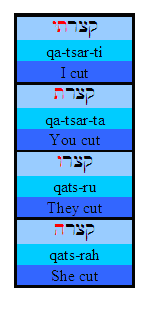
The phrase קצרתי עץ (qatsarti ets) would mean "I cut a tree," קצרו עץ (qatsru ets) would mean "They cut a tree" and the phrase קצרה עץ (qatsrah ets) would mean "she cut a tree."
The subject of the verb within each conjugation identifies person (first, second or third), gender (masculine or feminine) and number (singular or plural). The conjugation of the verb in קצרה עץ (qats'rah ets) identifies the subject as third person, feminine, singular - she. In קצרו עץ (qatsru ets) the subject is identified as third person, masculine plural - they (masc).
It is also common in Biblical Hebrew to include a noun or proper noun for the subject of the verb. In the sentence קצרה שרה עץ (qats'rah Sarah ets) the verb qats'rah identifies the subject of the verb as third person, feminine, singular. The proper noun Sarah specifically identifies the subject of the verb. Also note that in Hebrew subject of the verb follows the verb, unlike English where it precedes the verb.
Learn Hebrew Verbs - Verb Tenses
Each Hebrew verb also identifies the tense of the verb. In English a verb can have three tenses - past, present or future. Examples of these would be "You cut a tree" (past), "You are cutting a tree" (present) and "You will cut a tree" (future). Biblical Hebrew only has two tenses - perfect and imperfect. While the three verb tenses in English are related to time, Biblical Hebrew verb tenses are related to action. The perfect tense is a completed action while the imperfect tense is an incomplete action.
As we have learned, the verb קצרתי identifies the subject of the verb as first person - "I" but, it also identifies the verb as "perfect tense," a completed action - "I cut." When the verb is written as אקצר the subject of the verb is also first person - "I" but, the tense is now "imperfect tense," an incomplete action and can be translated as "I am cutting a tree" (an action that has begun but not yet completed) or "I will cut a tree" (an action that has not yet begun).
Below is a chart for a few verb conjugations in the perfect and imperfect tense. Notice that when the added letters are at the end of the verb they are in the perfect tense but when they are at the beginning (and maybe at the end as well) they are in the imperfect tense. This can help you easily identify the tense of the verb.
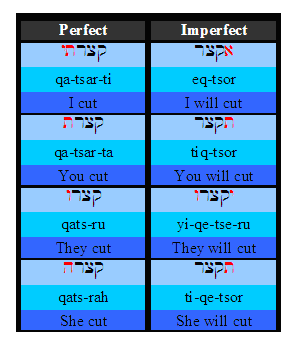
These conjugations are the same for any verb (though there are some exceptions which we will cover in another lesson). The chart below are the same conjugations as the chart above for the verb דבר (dabar) meaning to "speak."
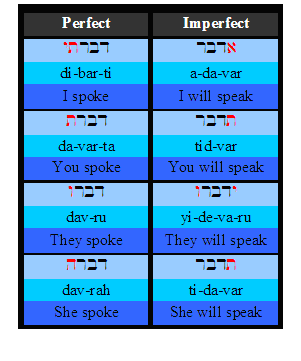
Below is a more detailed chart for all the conjugations for the verb qatsar in the perfect and imperfect tenses. By memorizing the various letters added to the root verb one can easily learn to identify the meaning of a verb. This chart is available in a PDF file. While additional verb forms will be learned in the upcoming lessons, about 90% of the verbs in the Hebrew Bible will use the forms listed in this chart.
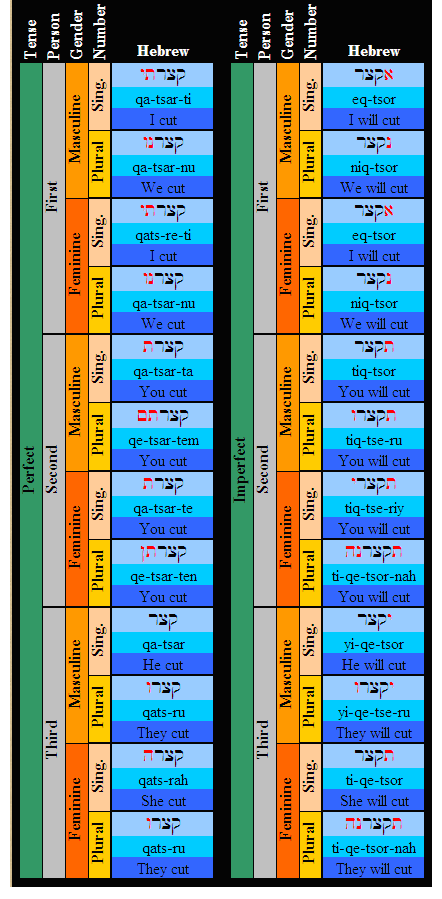
The letter ו (vav) is used as a prefix meaning "and." For instance, the word ועץ (v'ets) means "and a tree." This prefix can also be added to a verb such as in the sentence וקצרתי עץ (uqartsiy ets) which would mean "and I cut a tree." but, because the vav is prefixed to the verb it reverses the tense of the verb so, וקצרתי עץ would actually be "and I will cut a tree" (imperfect tense).
The sentence אקצר עץ (eq'tsar ets) means "I will cut a tree" but ואקצר עץ (ve'e'qatsar ets) means "and I cut a tree."
However, this is not a hard and fast rule. While the letter vav usually reverses the tense of the verb, it is not always the case and only the context of the phrase within the text will determine if the tense is reversed or not.
One other note, the negative particle לֹא (lo) precedes a verb to negate its action such as in the phrase לא קצר יעקב עץ which would be translated as "Jacob did not cut a tree."
Learn Hebrew Verbs - The Object of the Verb
The object of the verb can be identified by a noun, proper name or a pronoun. In the sentence "Jacob helped a man" the noun "man" is the object of the verb. In "Jacob helped John" the proper name "John" is the object and in "Jacob helped him" the pronoun "him" is object of the verb. The object of the verb works the same way in Hebrew such as in the sentences עזר יעקב יוחנן (azar Ya'aqov Yohhanan) meaning "Jacob helped John." When the object of the verb is identified by a pronoun it may be written in two different ways. The word אתו (oto) means "him" and can be used for the object of the verb such as in the sentence עזר יעקב אתו (azar Ya'aqov oto) meaning "Jacob helped him." Or the suffix ו (o), also meaning "him," may be attached to the end of the verb such as in the sentence עזרו יעקב (azaro Ya'aqov) also meaning "Jacob helped him."
It is not uncommon for the verb, subject of the verb and the object of the verb to be written as one word in Hebrew. The Aaronic blessing (Numbers 6:24) begins with the word יברכך (yevarekhekha) which is the verb ברכ (barak), meaning "to bless" with the prefix י (ye) identifying the subject of the verb as third person, masculine, singular - he and the suffix ך (kha) identifying the object of the verb as second person, masculine, singular - you. Therefore, the one word יברכך means "he will bless you."
Below is a list of the pronoun suffixes attached to a verb for the object of the verb. (These pronouns are also used as suffixes for nouns as well.)
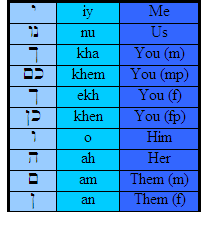
Learn Hebrew Verbs - Biblical Application
וַיֹּאמֶר אֱלֹהִים יְהִי אוֹר וַיְהִי־אוֹר׃
And Elohiym said, light will exist and light existed.
| וַיֹּאמֶר | This is the verb root אמר meaning "to say." The prefix י identifies the subject of the verb as third person, masculine, singular (he) and the tense of the verb as imperfect (he will say). The prefix ו, meaning "and," also reverses the tense of the verb (and he said). The subject of the verb is the word אֱלֹהִים (Elohiym) which follows this verb so, this would be translated as "and Elohiym said." | |
| יְהִי | This is the verb root היה meaning "to exist" or "to be." The prefix י identifies the subject of the verb as third person, masculine, singular (he) and the tense of the verb as imperfect (he will exist/be). The subject of the verb is the word אוֹר (or) which follows this verb so, this would be translated as "light will exist/be." Also notice that when a verb ending with the letter ה is conjugated, it is dropped from the verb. | |
| וַיְהִי | This is the verb root היה meaning "to exist" or "to be." The prefix י identifies the subject of the verb as third person, masculine, singular (he) and the tense of the verb as imperfect (he will exist/be). The prefix ו, meaning "and," also reverses the tense of the verb (and he existed/was). The subject of the verb is the word אוֹר (or) which follows this verb so, this would be translated as "and light existed/was." |
וַיִּישָׁן וַיִּקַּח אַחַת מִצַּלְעֹתָיו
And he slept and he took one of his ribs
| וַיִּישָׁן | This is the verb root ישׁן meaning "to sleep." The prefix י identifies the subject of the verb as third person, masculine, singular (he) and the tense of the verb as imperfect (he will sleep). The prefix ו, meaning "and," also reverses the tense of the verb (and he slept). | |
| וַיִּקַּח | This is the verb root לקח meaning "to take." The prefix י identifies the subject of the verb as third person, masculine, singular (he) and the tense of the verb as imperfect (he will take). The prefix ו, meaning "and," also reverses the tense of the verb (and he took). The objects of this verb and the preceeding verb are the two words that follow. Also notice that when the verb לקח is conjugated, the letter ל is dropped. While the letters ה and נ commonly drop from conjugated verbs, this is the only time that a ל is dropped. |
וַיִּהְיוּ שְׁנֵיהֶם עֲרוּמִּים
And the two of them existed naked
| וַיִּהְיוּ | This is the verb root היה meaning "to exist" or "to be." The prefix י and the suffix ו identify the subject of the verb as third person, masculine, plural (they) and the tense of the verb as imperfect (they will exist/be). The prefix ו, meaning "and," also reverses the tense of the verb (and they existed/were). The subject of the verb is the following word (and the two of them existed/were). |
וַתֹּאמֶר הָאִשָּׁה אֶל־הַנָּחָשׁ
And the woman said to the serpent
| וַתֹּאמֶר | This is the verb root אמר meaning "to say." The prefix ת identifies the subject of the verb as third person, feminine, singular (she) and the tense of the verb as imperfect (she will say). The prefix ו, meaning "and," also reverses the tense of the verb (and she said). The subject of the verb is the word meaning "the woman" so, this would be transated as "the woman said." |
וַיֹּאמֶר אֶת־קֹלְךָ שָׁמַעְתִּי בַּגָּן וָאִירָא
And he said, I heard your voice in the garden and I was afraid
| וַיֹּאמֶר | This is the verb root אמר meaning "to say." The prefix י identifies the subject of the verb as third person, masculine, singular (he) and the tense of the verb as imperfect (he will say). The prefix ו, meaning "and," also reverses the tense of the verb (and he said). | |
| שָׁמַעְתִּי | This is the verb root שׁמע meaning "to hear." The suffix תי identifies the subject of the verb as first person, singular (I) and the tense of the verb as perfect (I heard). | |
| וָאִירָא | This is the verb root ירא meaning "to fear." The prefix א identifies the subject of the verb as first person, singular (I) and the tense of the verb as imperfect (I will fear/I will be afraid). The prefix ו, meaning "and," also reverses the tense of the verb (and I feared/and I was afraid). |
כִּי עָשִׂיתָ זֹּאת
Because you did this
| עָשִׂיתָ | This is the verb root עשׂה meaning "to do." The suffix ת identifies the subject of the verb as second person, masculine, singular (you) and the tense of the verb as perfect (you did). |
יְשׁוּפְךָ רֹאשׁ וְאַתָּה תְּשׁוּפֶנּוּ עָקֵב
He will crush you a head and you will crush us a heel
| יְשׁוּפְךָ | This is the verb root שׁוּף meaning "to crush." The prefix י identifies the subject of the verb as third person, masculine, singular (he) and the tense of the verb as imperfect (he will crush). The suffix ך identifies the object of the verb as second person, masculine, singular (you). So, this word would be translated as "he will crush you." | |
| תְּשׁוּפֶנּוּ | This is also the verb root שׁוּף meaning "to crush." The prefix ת identifies the subject of the verb as second person, masculine, singular (you) and the tense of the verb as imperfect (you will crush). The suffix נוּ identifies the object of the verb as third person, singular (him). So, this word would be translated as "you will crush him" (The suffix נוּ is normally the first person, plural pronoun (us) but will sometimes be used for the third person, singular). |



